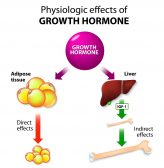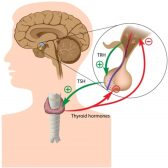Definition
noun, plural: thyroxines
An iodine-containing hormone (chemical formula: C15H11I4NO4) produced by the thyroid gland to regulate metabolism by controlling the rateof oxidation in cells
Supplement
In animals, hormones are substances produced and secreted by an endocrine gland, the ductless gland of the endocrine system. In humans and other vertebrates, the thyroxine is a hormone produced and secreted by the follicular cells (thyrocytes) of the thyroid gland of the endocrine system. In humans, the thyroid gland releases two types of thyroid hormones: (1) thyroxine and (2) triiodothyronine.
In humans, thyroxine is a thyroid hormone involved in the regulation of metabolism and the control of growth. Similar to triiodothyronine, thyroxine is tyrosine-based and has iodine as a structural component. Thyroxine is 65% iodine. Thus, a deficiency of iodine could hamper the production of these hormones, and manifest as a disease called simple goiter.
Thyroxines are released into the bloodstream and most of them are bound to proteins (e.g. thyroxine-binding globulin, transthyretin, albumin, etc.). Thyroxines are more predominant and have a longer half-life than triiodothyronines. Nonetheless, triiodothyronines are more potent than thyroxines. These thyroid hormones target nearly all cells of the body. Thyroxines cross the cell membrane via ATP-dependent carrier-mediated transport. Within the cell, thyroxine is converted into the active triiodothyronine by deiodinase enzyme. It is further processed to produce iodothyronamine and thyronamine. The triiodothyronine binds to the nuclear receptor, thyroid hormone receptor. The binding causes conformational change in the receptor, displacing the corepressor molecules. The corepressor together with the receptor binds DNA regions called thyroid hormone response elements near genes. The complex blocks the transcription of certain genes. Thus, the displacement of corepressor from the complex leads to the recruitment of coactivator proteins and RNA polymerase, and the subsequent activation of gene transcription.
Thyroxines and triiodothyronines are involved in augmenting basal metabolic rate. They are also involved in the regulation of protein, fat, and carbohydrate metabolism. They are also involved in stimulating vitamin metabolism. In other animals, such as mammals, they are involved in hibernation cycles. In birds, they are associated with the moulting behavior.
The thyroid stimulating hormone (TSH) targets the pituitary gland to release thyroxine. Negative feedback occurs when thyroxine levels in the body are high, as this inhibits the secretion of TSH.
Thyroxines may be synthetically produced for use as a medication in treating hypothyroidism.
Chemical formula:
- C15H11I4NO4
Abbreviation:
Variant(s):
- thyroxin
Synonym(s):
See also:
- hormone
- thyroid stimulating hormone




